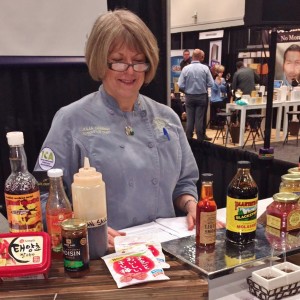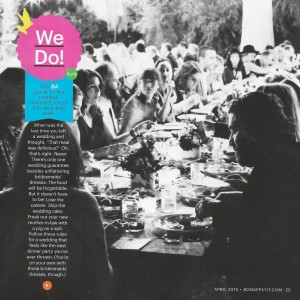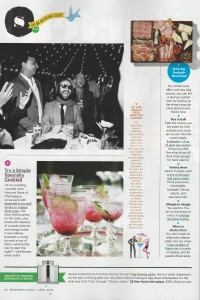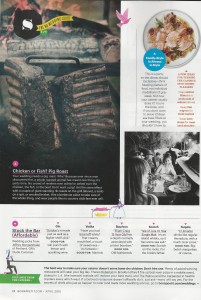I had the opportunity last week to teach a seminar on the trade show floor of the largest specialized catering and events conference in the United States, held at Mirage Hotel in Las Vegas, and at the Las Vegas Convention Center. Another chef was designated to teach this class, but was not available due to prior commitments, so I got the call. It was a great opportunity to summarize some of the flavor profile trends we have been seeing out here in California, and how they can be applied to catering menus for large and small caterers across the country.
The first step in preparation was to Google this year’s food trends, though I was pretty confident that I knew what I would find. Many “new” ideas for the rest of the country have been on our menus in California for a couple of years, due to our vibrant and innovative restaurant scene and a heavy focus on diversity and local and sustainable foods. The usual things popped up, “farm-to-table”, small artisan producers, all the buzzwords. But how to translate this to a seminar entitled “The Condiment Circus: Three Rings of Flavor”? I set down the laptop and headed to our pantry to see what was on the shelf.
In the pantry, I found Gochujang (Korean fermented chili paste), Mae Ploy Sweet Chili Sauce, gluten-free hoisin sauce from Wok Mei, a large bottle of Vietnamese fish sauce, salted Japanese dried plums (umeboshi), and a quart jar of preserved Meyer lemons that we use in preparing our vegetable tagine. Digging further, I found all-natural liquid smoke and blackstrap molasses, which we use to approximate the flavor of bacon in vegan preparations, and an assortment of finishing salts. On the counter were a full slate of Stella Cadente Olive Oil’s crushed flavored California oils, and more salts and salt blends. A trip to the reach-in yielded our Korean BBQ sauce, house-made Romesco and a couple of jars of fruit mostarda that we prepared to accompany roast pork. Now I had a basis for a seminar on condiments.
A list was assembled for the event organizers (all the condiments had to be readily available, either through foodservice distribution or via the internet, mostly from Amazon Prime). Many of the caterers at this conference were rural and small market, like myself, and did not have access to the well-stocked ethnic grocers found in larger urban areas. I dug through my recipe files, and came up with half a dozen recipes, complete with photos, of ways to integrate these condiments and flavor profiles without scaring our clients into the woods. I included the recipe for the Korean BBQ sauce, plus a couple of recipes for appetizers using it. A recipe for a baby chicory and beet salad with a robust vinaigrette pulled in the Blood orange olive oil and the sweet chili sauce. Of course, the crowning glory would be our vegan eggplant “bacon”, a recipe inspired by a Pinterest find when researching vegan brunch ideas. I added our recipe for Romesco, even though we would be tasting a retail version, and a couple more photos of dishes using some of the other items such as the finishing salts.
The main focus of the seminar was to have the attendees taste each of the condiments, then taste some of the foods derived from them. This meant tons of little dishes and spoons that had to be laid out in order in the back of the house, set for 30-50 attendees. Setup took me most of an hour and a half, but we were finally ready. Up to the mike, assistants all set to pass out the tasting portions and off we go.
The first taste was the Gochujang, a fermented bean and chili paste from Korean that is as ubiquitous as catsup is in the United States. It has a nice heat, balanced with the complexity of fermentation, and strong notes of umami. It was accompanied by a taste of the Korean BBQ sauce, made based on the Gochujang. The sauce also included brown sugar, tamari, toasted sesame oil and rice vinegar. Everyone loved how the other sauce components tempered the heat and the resultant sauce could be used in a variety of ways.
The second taste was the Thai Mae Ploy Sweet Chili Sauce. This was an easy one for most of the attendees, as it has a nice balance of sweetness, heat and acidity. This was followed by the Vietnamese fish sauce, which can be used as a shelf stable substitute for anchovy in many recipes. Next up was the Japanese salt-dried plum, which we use to flavor steamed sticky rice as a side dish for Asian inspired pork dishes. While the plum itself is salty and astringent, the finished rice reflects the subtle fruitiness and aromatics of the plum. The last Asian inspired taste was the hoisin, noted as a great way to bring Asian flavors to BBQ sauces.
On the same spoon as the hoisin, the attendees tasted blackstrap molasses, as a segue into the north American market basket. They noted the similarities in the flavors, bitter plus sweet plus umami, and how each culture used these flavors in certain ways. They then were given a tiny spoon of the liquid smoke. We discussed the recognizable flavors in bacon and other preserved pork product (salty, sweet, bitter, smoky) and we presented a taste of the vegan “bacon”, thinly sliced eggplant painted with a mixture of the molasses, liquid smoke, maple syrup and tamari, then baked in a low oven until crisp.
We followed the bacon with the flavored olive oils, both the Blood orange and the basil, and discussed how these could not only be incorporated into dressings, but used as sauce replacements and in marinades.
We then moved to the old-world market basket, with hot harissa and the preserved lemons from Morocco, discussing the use of these condiments across the southern and eastern Mediterranean. Everyone was struck by the influence of the Arabic world in even new world cuisines. The next taste was traditional Mostarda di Frutta; whole baby fruit preserved in sugar syrup and hot mustard from northern Italy. Noticing the likeness to chutney, the attendees were quick to grasp how this could be flexible enough to move from the cheese and charcuterie plate to the entrée, especially with roast meats such as chicken and pork.
The last tastes we enjoyed were the finishing salts. We presented two Hawaiian salts, the dusty pink Ali’i and the black lava salt. Both are great for garnishing, both with color and their earthy mineral flavors. We love using the pink salt on a big basket tray of steamed edamame, and use the black salt in many of our passed appetizer where the color is a counterpoint to the ingredients presented. The next salts tasted were our house-made duck salt and porcini mushroom salt, and we discussed using our spice grinder to prepare these from on-hand ingredients. A very effective method to use when layering flavors. Our example was a recipe for duck confit risotto; made with duck stock, shredded confit duck meat, sautéed in duck fat, and topped with a quenelle of duck foie gras. The finishing touch was a sprinkling with duck salt (the rendered skin pulverized in the food processor then mixed with kosher salt). The last salt tasted was SaltWork’s Salish alder-smoked sea salt. We use this salt frequently to finish plates of roasted or grilled meats, especially beef, as it brings out the flavor of the cooking method in a subtle way.
Discussion ensued during the question and answer period about the differences and commonalities in the various cultures and their condiments. Everyone left with new ideas and inspirations to take back to their own kitchens. For presentation materials, see below. Contact us via email at info@assaggiare.com for recipes. For information about Catersource/Event Solutions conference and trade show, click here.
Condiment Circus
Gochujang: Korean fermented hot pepper sauce (hot, fermented)
Thai Sweet Chili Sauce (Mae Ploy): Southeast Asian chili pepper jam (hot, sweet)
Natural Liquid Smoke: (bitter, smokiness)
Blackstrap Molasses: (bitter, sweet)
Flavored Olive Oils (www.stellacadente.com): (umami, fruit notes, herb notes)
Romesco: Spanish sauce of almonds, bread, tomato, paprika, peppers (umami)
Harissa (Mustapha’s): Moroccan chili paste (heat)
Preserved Lemon (Mustapha’s): Moroccan salt pickled whole sweet lemons (acid, salt fermented)
Fish Sauce: Southeast Asian, made from fermented small fish (umami, fermented)
Umeboshi: Japanese salt dried “pickled” plums (sour, sweet, salt)
Hoisin (Wok Mei is gluten free): Chinese “BBQ” sauce, fermented beans with soy, rock sugar (umami, sweet)
Mostarda: Northern Italian fruit preserved in syrup with mustard seed (sweet, hot)
Finishing Salts (www.seasalt.com): smoked, meat flavored (duck), mushroom, herb (salt, various flavors)
All of these condiments can be used to layer flavors in a dish, bring out specific notes in the flavor profiles, replicate flavors from other types of foods, enhance specific elements of flavor such as umami, sweetness, astringency and acidity.
Condiments available on Amazon Prime unless otherwise noted.







